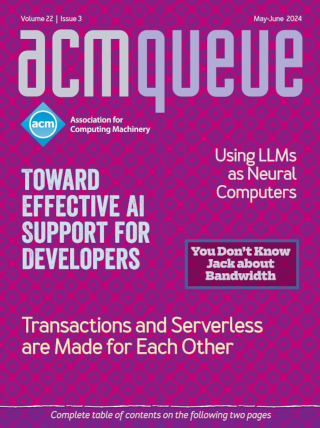SoC: Software, Hardware, Nightmare, Bliss:
System-on-a-chip design offers great promise by shrinking an entire computer to a single chip. But with the promise come challenges that need to be overcome before SoC reaches its full potential.
System-on-a-chip (SoC) design methodology allows a designer to create complex silicon systems from smaller working blocks, or systems. By providing a method for easily supporting proprietary functionality in a larger context that includes many existing design pieces, SoC design opens the craft of silicon design to a much broader audience.
Sentient Data Access via a Diverse Society of Devices:
Today’s ubiquitous computing environment cannot benefit from the traditional understanding of a hierarchical file system.
It has been more than ten years since such "information appliances" as ATMs and grocery store UPC checkout counters were introduced. For the office environment, Mark Weiser began to articulate the notion of UbiComp and identified some of the salient features of the trends in 1991. Embedded computation is also becoming widespread. Microprocessors, for example, are finding themselves embedded into seemingly conventional pens that remember what they have written. Anti-lock brake systems in cars are controlled by fuzzy logic.
Putting It All Together:
Component integration is one of the tough challenges in embedded system design. Designers search for conservative design styles and reliable techniques for interfacing and verification.
With the growing complexity of embedded systems, more and more parts of a system are reused or supplied, often from external sources. These parts range from single hardware components or software processes to hardware-software (HW-SW) subsystems. They must cooperate and share resources with newly developed parts such that all of the design constraints are met. This, simply speaking, is the integration task, which ideally should be a plug-and-play procedure. This does not happen in practice, however, not only because of incompatible interfaces and communication standards but also because of specialization.
Programming Without a Net:
Embedded systems programming presents special challenges to engineers unfamiliar with that environment.
Embedded systems programming presents special challenges to engineers unfamiliar with that environment. In some ways it is closer to working inside an operating system kernel than writing an application for use on the desktop. Here’s what to look out for.
Division of Labor in Embedded Systems:
You can choose among several strategies for partitioning an embedded application over incoherent processor cores. Here’s practical advice on the advantages and pitfalls of each.
Increasingly, embedded applications require more processing power than can be supplied by a single processor, even a heavily pipelined one that uses a high-performance architecture such as very long instruction word (VLIW) or superscalar. Simply driving up the clock is often prohibitive in the embedded world because higher clocks require proportionally more power, a commodity often scarce in embedded systems. Multiprocessing, where the application is run on two or more processors concurrently, is the natural route to ever more processor cycles within a fixed power budget.
Blurring Lines Between Hardware and Software:
Software development for embedded systems clearly transcends traditional "programming" and requires intimate knowledge of hardware, as well as deep understanding of the underlying application that is to be implemented.
Motivated by technology leading to the availability of many millions of gates on a chip, a new design paradigm is emerging. This new paradigm allows the integration and implementation of entire systems on one chip.
A Conversation with Jim Ready:
Linux may well play a significant role in the future of the embedded systems market, where the majority of software is still custom built in-house and no large player has preeminence.
Linux may well play a significant role in the future of the embedded systems market, where the majority of software is still custom built in-house and no large player has preeminence. The constraints placed on embedded systems are very different from those on the desktop. We caught up with Jim Ready of MontaVista Software to talk about what he sees in the future of Linux as the next embedded operating system (OS).






